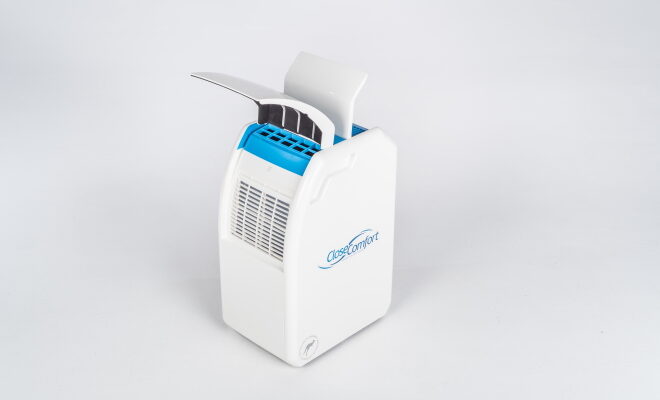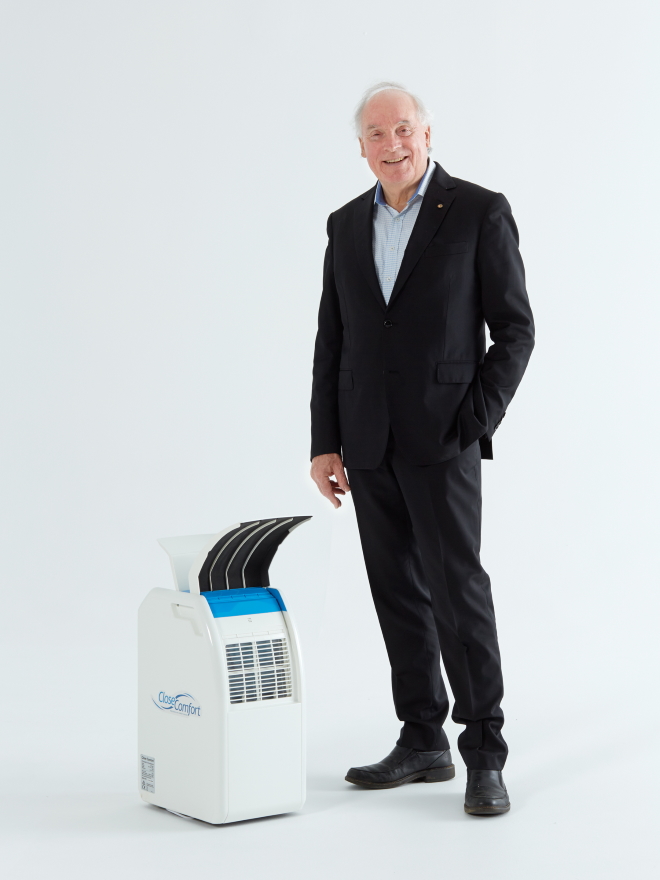
Insights + interviews
Close Comfort for affordable, efficient and sustainable cooling solutions
Professor James Trevelyan shares about Close Comfort, and his new cooling solution – the Cool Focus.
Close Comfort is an Australian and Singapore based start-up, founded by Professor James Trevelyan. They have a mission to provide affordable yet efficient and sustainable cooling solutions.
With the recent introduction of Close Comfort’s portable cooling solutions – Cool Focus, Professor James has created products that are cheaper, and more environmentally friendly.
According to figures provided by Close Comfort, when compared to traditional air conditioners, the Cool Focus costs less to operate for 9 hours of operations, uses 80 percent less refrigerants and emits 50 percent less CO2.
The Active Age discusses with Professor James about current cooling systems, and his focus on 22°C as the optimal temperature.
the Active Age (AA): How did you get started on cooling solutions as a category?
Professor James Trevelyan (JT): I had the privilege of listening to Paul Polak, an entrepreneur who advised the Stanford University D-School headed by Prof. Bernie Roth, a friend of mine. He explained that if you plan to improve the world, you need to invent something that’s going to benefit at least a million people. And that magical invention has to create businesses for people who are going to distribute it. It has to be a commercial venture from the start. He also said it helps if you have experienced the need for it yourself.
Around the same time, I had experienced the intense heat of summer in Pakistan and India. Sleep was elusive: the air-conditioner would die regularly with routine electricity load shedding. Often in the early hours I lay in 40°C heat, in silent darkness, sweat running down my face, listening for the mosquitoes, waiting for the power to return so that the room air-conditioner would allow me to sleep. I thought there has to be a better way to keep cool and it has to run on a battery backup power supply. 300 Watts. The idea for Close Comfort was born.
I thought it would be easy to build a tiny air-conditioner that would provide just enough fresh cool air to allow me to sleep. It was a tough technical challenge in the end. It took years.
When I first took a prototype to Pakistan in 2013, local people were overwhelmed with excitement. They could immediately appreciate the value of an air-conditioner that would run on so little power. They asked me “how much would it cost to buy one?” I had no idea how to answer. That thought had never crossed my mind because to me it was just a technical challenge. So, instead, I asked them “how much would you pay for it?”
The answer nearly blew me away. Between $300 and $400, much more than I had thought they would say.
That was the moment that I realised that Close Comfort could be a commercial venture.
AA: How do current cooling solutions in the market, e.g. air-conditioning, damage the environment? Tell us about close comfort and what you’re trying to achieve.
JT: Traditional room air-conditioners consume vast amounts of energy because they need to cool the building structure, the walls, the floor, the furniture as well as the people in the building. Only a tiny amount of the energy actually cools people. Generating all that energy creates lots of carbon oxide emissions and other pollution, contributing to global warming, especially in countries like Australia and Singapore where fossil fuels generate most of the electricity. In hot weather, as much as half of all the energy generated runs air-conditioners. But it doesn’t stop there.
Air-conditioners rely on special refrigerant gases. These gases leak through the lifetime of a typical split air-conditioner and need to be topped up every year or so. The entire refrigerant charge is lost and leaks into the atmosphere at the end of the life of an air-conditioner. Even though only a small amount of gas is involved, refrigerants are extremely potent greenhouse gases. They have much more effect on global warming than carbon dioxide. Current refrigerants are between 600 and 2,000 times more powerful at creating global warming.
A third effect on the environment is urban heating. Cities are hotter than the surrounding countryside, partly because of air-conditioning. Especially in very hot weather, air-conditioners run flat out, extracting heat from buildings and pumping it into the surrounding area in the city streets. For example, Sydney can be up to 9°C hotter than the surrounding countryside on a summer’s day. Because of this “urban heat island effect” cities are warming several times faster than the global climate. Cars and other machinery also contribute heating too. And cars have their own air conditioners!
If there were just a few air-conditioners it wouldn’t really matter. These days, however with urban heating, global warming and rising prosperity in many countries, the number of air-conditioners is growing extremely rapidly. Scientists have estimated that traditional air-conditioners could add as much as half a degree extra global warming by the end of the century if we don’t do something very soon.
Close Comfort avoids all these problems. It uses a tiny fraction of the amount of energy, reducing the need for electricity and reducing urban heating. It uses only a tiny amount of refrigerant, and from next year we will be using a natural refrigerant with negligible effect on global warming. So it’s a truly sustainable solution. It’s even better for health!
At Close Comfort we want everyone on the planet to have air-conditioned comfort without literally cooking the climate.
It’s not just a matter of sustainability.
In low income countries, only about 3 percent of the population can afford routine air-conditioning through hot summer months. Many more have air-conditioners in their homes but can only afford to use them for special occasions. Close Comfort is far more affordable. As we make more and more, and reduce the manufacturing cost, our goal is to make air-conditioning affordable for everybody with negligible impact on the climate and the planet’s ecosystem. Close Comfort will be an essential companion in a warming world. We want that warming to be as little as possible. And we want people to be reasonably comfortable so that they can enjoy healthy sleep and work productively during the day to support their families.
Question 3 What is unique about Close Comfort schooling solutions?
Unlike traditional air-conditioners, we cool people, not buildings. We focus the cooling just where it’s needed, on one or two people sitting nearby. We create a microclimate that provides sufficient comfort to enjoy sleep and work.
Close Comfort is a compressor-driven refrigeration air-conditioner. That means it works even more effectively in hot and humid weather, unlike water evaporative coolers.
What’s unique about Close Comfort is the technology that we use to focus a small amount of cool air just where it’s needed most.
Question 4: Why is there a focus on 22°C as the optimal temperature? Can you share some background and context?
Air-conditioning was first introduced in America to control temperature and humidity in factories, for example to stop paper from wrinkling because of humidity. Later, cinema owners installed large air-conditioning systems so that people would find it was so comfortable to spend the day there in hot weather. Once air-conditioners were miniaturised after the Second World War, they were heavily promoted by their manufacturers, becoming an essential feature in city offices.
To make it easier to design building air-conditioning systems, engineers performed many experiments, trying to find just the right temperature for American businessmen wearing suits. It turned out to be 22°C. That was the temperature at which the greatest proportion of businessmen felt comfortable. It became the de-facto world standard even though businessmen no longer wear suits! That’s why we walk into buildings in Singapore with cardigans or scarfs, just to keep warm enough.
What’s really interesting is that once you give people the option of adjusting the building temperature, they leave the setting at 22°C, summer and winter. Before air-conditioning, people found ways to be comfortable at much lower temperatures in winter and considerably higher temperatures in summer. People also adapted to changing temperatures. That’s why people who live routinely in a tropical climate feel comfortable at a temperature of about 28°C whereas people in temperate climates tend to feel comfortable at about 24° C. People who live in cold climates routinely can feel quite comfortable at indoor temperatures of 15° C.
What makes it more complicated is that air-conditioning systems in modern offices and hotels are extremely difficult to adjust. Once technicians have set up the system to operate at around 22° C, no one wants to try and adjust the temperature up or down. It’s just too difficult.
It’s easy enough to adjust the thermostat in a particular hotel room with the doors closed. But it’s much more difficult in an open plan offices where doors are open and closed at different times through the day, people come and go, and machines like computers churn out heat.

Question 5: What are the benefits for close comfort’s customers and how can they find out more about your solutions?
Probably the biggest benefit for people in Singapore and Australia is convenience. Close Comfort offers cool fresh air wherever you need it. You just plug it into the nearest power point, open the flaps and away you go, in seconds. You don’t need to be close to a window to install the big pipes that come with traditional portable air conditioners.
You can even use it with the doors and windows open so that you live in healthy fresh air all the time. There’s no need for that split air-conditioner which just recirculates stale room air, with carbon dioxide and volatile organic compounds steadily accumulating.
Unquestionably, saving on electricity bills is a big benefit from using Close Comfort. Typically in Singapore and Australia, electricity usage will be cut by at least 75 percent while you use it. You can keep your split system air conditioner for cooling a crowd when you need it. The rest of the time you can happily use Close Comfort to keep comfortable.
Another big advantage of Close Comfort is that it is quiet. It’s no more noisy than a typical electric fan. That means it’s easy to sleep with, unlike traditional portable air conditioners with those ugly big pipes.
Another great advantage is that it is so easy to carry and move around. Traditional so-called “portable” air-conditioners with big pipes weigh 35 to 40 kg. I don’t know why people call them portable!
Health, convenience, economy… And sustainability.
With Close Comfort you know you are reducing your environmental footprint as much as possible. It makes you feel better.
Many of our customers have also reported significant health benefits. We are just a small start-up company so we don’t have the budget for scientifically controlled trials: we have to rely on what our customers tell us. Many have told us that they breathe easier, suffer less from dehydration and skin irritations, and wake feeling healthier in the morning.
As you would know, the sick building syndrome associated with traditional air-conditioning is no joke. Close Comfort avoids all the characteristics that make sick building syndrome a real problem for office workers. That’s why it’s an ideal companion for working at home.
Images shared by Close Comfort.







